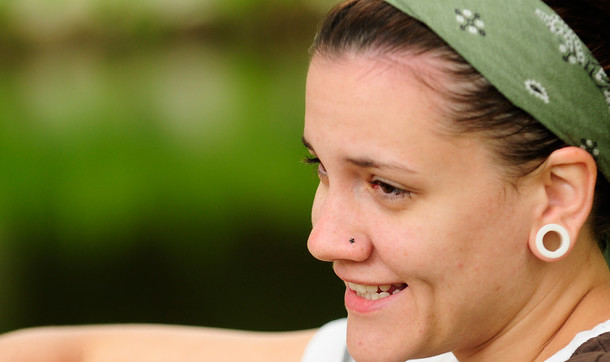
Film and Media Studies, along with a few other departments premiered the academy award-nominated documentary “Poster Girl” at the Johnson Center cinema last Wednesday.Photo courtesy Poster Girl
Film and Media Studies, along with a few other departments premiered the academy award-nominated documentary “Poster Girl” at the Johnson Center cinema Wednesday.
The film documents the struggle of an army Iraq war veteran, Robynn Murray, against her debilitating effects of war, including post-tramatic stress disorder. Murray, along with the film’s director Sarah Nesson, sat down before the showing to express their thoughts and feelings.
Why do you think “Poster Girl” is an important film?
Sara Neeson: I think what’s really great about Robynn is that she personalizes PTSD. She’s making it palatable; she’s helping people understand what it’s like. I think there’s a huge disconnect between what veterans are really going through and what the media shows veterans going through.
And so for most people to get to see Robynn, it really helps them understand PTSD and therefore put a face to this horrible issue that we have in our country.
Robynn Murray: Given how many veterans are committing suicide — I think it’s 5,000 in a year, which is approximately 18 veterans a day — I think that the information that people are getting, with how we suffer, with how I suffered, it’s not really something that they can ignore anymore, having seen exactly what it does to a person.
It’s not just something that someone’s heard of. They don’t just think they know what it is. It’s very apparent after watching the film.
Sarah, in light of the film’s success, being chosen for so many festivals and nominated for an Academy Award, are you looking at any bigger projects in the near future?
SN: I’m still working on getting “Poster Girl” out there and distributing it and going on tour with it, so that’s a big part of making a film. But I’m also developing other projects. Robynn and I are in development on a feature film that’s going to be an adaptation of “Poster Girl.”
Right now, we’re looking at screenwriters and so we hope to get that going. I also am working on a series I want to do on vets and PTSD to show what kind of programs are out there that are actually helping veterans in more comprehensive and intensive ways other than the [Veterans Affairs].
Robynn, what inspired you to enlist in the US Army at such an early age?
RM: I enlisted in October of 2003. I was in the early enlistment program for a few months before. I think that I joined for the same reasons that every kid joins.
I had a family with a lot of military members in it. I didn’t have a lot of money. I was actually a non-contracted ROTC cadet at the time that I enlisted and I thought that had I been enlisted I would have made a better officer.
The laundry list goes on and on and on. I grew up in Niagara Falls, which is the Rust Belt. It’s very economically depressed. There aren’t a lot of jobs. So an easy way to get a decent job is if you served in the military. I had been considering that even back then. It’s just a very complex mathematical equation.
What’s the worst part of living with PTSD?
RM: The isolation you feel when no one understands you and when you feel like you come home to a society that doesn’t care about you anymore.
I remember being really frustrated, having no money and being disabled, and seeing people with yellow ribbon stickers that said “support your troops” and it’s like “Yeah, well what are you doing now?”
And it seems like people want to support the troops while they’re in and send care packages then, but what happens when you can’t be a soldier anymore? What happens to all the service members at Walter Reed?
Sarah, why did you choose to document this subject in particular? How did you find Robynn?
SN: My dad was the one who really gave me the courage to go out and do something. I thought about some vets I knew who were making art from their uniforms.
It’s called the Combat Paper Project and they literally take their uniforms and they cut them up and pulp them to fiber and make all kinds of art.
I really should show what they’re doing — it’s so unique, it’s so healing. I just started filming them and over the next year and a half I realized I was making a documentary.
And then I met Robynn and realized that she had a really powerful voice and she was about to go through the VA at the time and that was something I really wanted to show — the struggle dealing with this bureaucratic nightmare.
What do you hope audiences will take away from this film?
RM: Don’t ignore your veterans anymore. When you see the politicians or the people kind of using them for rhetoric in a campaign, ignore that. The best thing that has come out of this is when people ask me “What can we do to help?” and that’s the most I could have really ever hoped for.
If any good can come of it — if it effects legislation or if it helps start a program or a group home, if it keeps one veteran from killing [himself], that’s a good job. I’ll be happy with that.
SN: The film shows the consequence of war. We can’t blame terrorists for that. That’s totally on us.
We have a responsibility to take care of them not just when they’re over there but when they come home. Robynn’s story represents one of many who are really struggling right now.






Comments